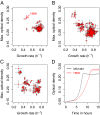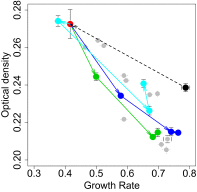Availability of public goods shapes the evolution of competing metabolic strategies
- PMID: 23940318
- PMCID: PMC3761572
- DOI: 10.1073/pnas.1308523110
Availability of public goods shapes the evolution of competing metabolic strategies
Abstract
Tradeoffs provide a rationale for the outcome of natural selection. A prominent example is the negative correlation between the growth rate and the biomass yield in unicellular organisms. This tradeoff leads to a dilemma, where the optimization of growth rate is advantageous for an individual, whereas the optimization of the biomass yield would be advantageous for a population. High-rate strategies are observed in a broad variety of organisms such as Escherichia coli, yeast, and cancer cells. Growth in suspension cultures favors fast-growing organisms, whereas spatial structure is of importance for the evolution of high-yield strategies. Despite this realization, experimental methods to directly select for increased yield are lacking. We here show that the serial propagation of a microbial population in a water-in-oil emulsion allows selection of strains with increased biomass yield. The propagation in emulsion creates a spatially structured environment where the growth-limiting substrate is privatized for populations founded by individual cells. Experimental evolution of several isogenic Lactococcus lactis strains demonstrated the existence of a tradeoff between growth rate and biomass yield as an apparent Pareto front. The underlying mutations altered glucose transport and led to major shifts between homofermentative and heterofermentative metabolism, accounting for the changes in metabolic efficiency. The results demonstrated the impact of privatizing a public good on the evolutionary outcome between competing metabolic strategies. The presented approach allows the investigation of fundamental questions in biology such as the evolution of cooperation, cell-cell interactions, and the relationships between environmental and metabolic constraints.
Keywords: droplets; group selection; metabolic engineering; microbial diversity; r/K selection.
Conflict of interest statement
The authors declare no conflict of interest.
Figures




Similar articles
-
Serial propagation in water-in-oil emulsions selects for Saccharomyces cerevisiae strains with a reduced cell size or an increased biomass yield on glucose.Metab Eng. 2021 Mar;64:1-14. doi: 10.1016/j.ymben.2020.12.005. Epub 2021 Jan 5. Metab Eng. 2021. PMID: 33418011
-
Task Distribution between Acetate and Acetoin Pathways To Prolong Growth in Lactococcus lactis under Respiration Conditions.Appl Environ Microbiol. 2018 Aug 31;84(18):e01005-18. doi: 10.1128/AEM.01005-18. Print 2018 Sep 15. Appl Environ Microbiol. 2018. PMID: 30030222 Free PMC article.
-
Redox balance is key to explaining full vs. partial switching to low-yield metabolism.BMC Syst Biol. 2012 Mar 24;6:22. doi: 10.1186/1752-0509-6-22. BMC Syst Biol. 2012. PMID: 22443685 Free PMC article.
-
Public goods and metabolic strategies.Curr Opin Microbiol. 2016 Jun;31:109-115. doi: 10.1016/j.mib.2016.03.007. Epub 2016 Apr 4. Curr Opin Microbiol. 2016. PMID: 27054480 Review.
-
The tragedy of the commons in microbial populations: insights from theoretical, comparative and experimental studies.Heredity (Edinb). 2008 Mar;100(3):233-9. doi: 10.1038/sj.hdy.6801073. Epub 2007 Oct 24. Heredity (Edinb). 2008. PMID: 17957201 Review.
Cited by
-
Costs of antibiotic resistance - separating trait effects and selective effects.Evol Appl. 2015 Mar;8(3):261-72. doi: 10.1111/eva.12187. Epub 2014 Jul 14. Evol Appl. 2015. PMID: 25861384 Free PMC article. Review.
-
Transcriptional response of Lactococcus lactis during bacterial emulsification.PLoS One. 2019 Jul 25;14(7):e0220048. doi: 10.1371/journal.pone.0220048. eCollection 2019. PLoS One. 2019. PMID: 31344087 Free PMC article.
-
Indirect Enrichment of Desirable, but Less Fit Phenotypes, from a Synthetic Microbial Community Using Microdroplet Confinement.ACS Synth Biol. 2023 Apr 21;12(4):1239-1251. doi: 10.1021/acssynbio.3c00008. Epub 2023 Mar 17. ACS Synth Biol. 2023. PMID: 36929925 Free PMC article.
-
Trade-offs between microbial growth phases lead to frequency-dependent and non-transitive selection.Proc Biol Sci. 2018 Feb 14;285(1872):20172459. doi: 10.1098/rspb.2017.2459. Proc Biol Sci. 2018. PMID: 29445020 Free PMC article.
-
Nutrient colimitation is a quantitative, dynamic property of microbial populations.Proc Natl Acad Sci U S A. 2024 Dec 24;121(52):e2400304121. doi: 10.1073/pnas.2400304121. Epub 2024 Dec 18. Proc Natl Acad Sci U S A. 2024. PMID: 39693349 Free PMC article.
References
-
- Beldade P, Koops K, Brakefield PM. Developmental constraints versus flexibility in morphological evolution. Nature. 2002;416(6883):844–847. - PubMed
-
- Velicer GJ, Lenski RE. Evolutionary trade-offs under conditions of resource abundance and scarcity: Experiments with bacteria. Ecology. 1999;80:1168.
-
- Fitzsimmons JM, Schoustra SE, Kerr JT, Kassen R. Population consequences of mutational events: Effects of antibiotic resistance on the r/K trade-off. Evol Ecol. 2009;24:227–236.
Publication types
MeSH terms
LinkOut - more resources
Full Text Sources
Other Literature Sources

